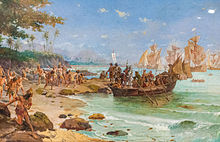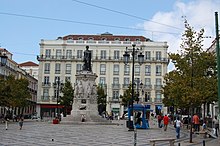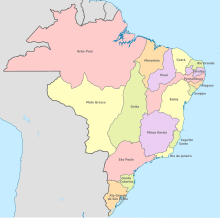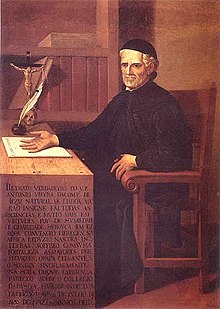Brazilian-Portuguese relations

|
|
|
|
|
| Brazil | Portugal |
The Brazilian-Portuguese relations describe the intergovernmental relationship between Brazil and Portugal . The relationship goes back to the arrival of the Portuguese explorer Pedro Álvares Cabral in 1500, who was the first European to land in the hitherto unknown South America . Brazil then belonged to the Portuguese colonial empire for more than three centuries .
The two countries are still closely linked to this day, with Brazil, with its almost twenty times larger population and almost a hundred times larger area, playing the larger international role. In addition to the common Portuguese language and the close relationships in business, culture, sport and politics, there is also a wealth of further connections at all other levels, from diverse relationships between citizens of both countries to international institutions such as joint membership in the community of Portuguese speakers Countries and the Ibero-American Conference of Nations . Mutual migration is also of great importance.
history

Until independence in 1822
With the landing of the Portuguese explorer Pedro Álvares Cabral in Porto Seguro on April 22, 1500, the Portuguese Crown began to take possession of the previously unknown Brazil. After the Portuguese-Spanish Treaty of Tordesillas , which was concluded in 1494 , the territory belonged to the King of Portugal, who in 1534 divided it into Capitanias and gave it to Portuguese nobles, the Capitães-Mor .
The Portuguese met the peaceful indigenous people of Brazil . On the one hand, they then tried unsuccessfully to enslave the natives. On the other hand, there was also a mix and cultural rapprochement. That left Guaraní long as the lingua franca prevailed in much of the colony until Portuguese. The Portuguese Caramuru is one of the most famous colonists who married Brazilian indigenous women and became important liaisons between the old and new Brazilian population. Later, the Jesuit priest António Vieira became the best-known advocate of the indigenous people of Brazil and openly criticized their situation, which had become unlawful.
After the initial export of the eponymous Brazilian wood , the cultivation of sugar cane became the most important economic factor in the new colony, which also stimulated the Portuguese slave trade with its increasing demand for slaves from the Portuguese possessions in Africa . Today's Afro-Brazilian culture has its roots here, for example with the Afro-Brazilian religions , musical instruments such as the berimbau , the batuque or the internationally known capoeira fighting dance.
With the end of the Portuguese succession in 1580, Portugal came into a personal union with the Kingdom of Spain . As a result, the Portuguese possessions weakened and Brazil suffered a series of attacks, mainly French and Dutch. With the regained independence of Portugal after the Restoration War from 1640, Portugal increased its attention to Brazil again and looked there for new sources of income that the bled mother country urgently needed.
In 1649 the Portuguese King D. João IV founded the General Society of the Brazilian Trade ( Portuguese : Companhia Geral do Comércio do Brasil ), which was primarily supposed to control and optimize the sugar and slave trade. It could not fully meet commercial expectations in the further course, but played an important role in the military safeguarding of overseas trade between Portugal and Brazil in the second half of the 17th century. It was of decisive importance in January 1654 in the final expulsion of the Dutch from the Brazilian northeast, where the Dutch West India Company had established itself from 1624.
The onset of mining of Brazilian mineral resources in the 17th century, especially gold, again led to enormous wealth, which was evident both in the outflow of immense capital flows into motherland Portugal and in the colony itself. The architectural heritage in baroque cities such as Ouro Preto or the then capital Salvador (today both UNESCO World Heritage cities ) have been preserved as evidence in Brazil, while in Portugal the numerous mansions and gilded church altars ( Talha dourada ) bear testimony to this renewed wealth to this day.
From the 17th century on, the so-called Bandeirantes moved further inland in search of gold, diamonds and slaves. They thus expanded the territory of Brazil beyond the original boundaries of the Tordesillas Treaty. As a result, a separate Brazilian identity was increasingly developing.
Coffee cultivation came to Brazil in the 18th century and later played an important role in the development of Brazil. The prosperous “coffee barons” were a consequence of this new economic factor and shifted the economic center of Brazil to the south. As a result, Rio de Janeiro replaced the capital Salvador as the most important city in the colony and became the capital in 1815. In addition, the bourgeois São Paulo grew in importance. The tendency towards a Brazilian society of its own, which had arisen for a long time, intensified considerably, with the Tiradentes uprising in 1792 as the final awakening signal for the Brazilian independence movement .
With the flight of the Portuguese royal family from the Napoleonic invasion of Portugal , Rio de Janeiro became the de facto capital of the Kingdom of Portugal in 1808 , thus effectively the first capital of a colonial empire located in a colony, a historically unique case. In the following development up to the Liberal Revolution in Portugal , Brazil was first upgraded as part of the United Kingdom of Portugal, Brazil and the Algarve (1815-1822). However, a civil society of its own had already developed in Brazil. At the Congress of Vienna in 1815, Brazil and Portugal were established as equal kingdoms. Brazil was no longer a colony.
After the end of the French threat in Portugal, King D. João VI returned. In 1821 he was reluctant to return to Lisbon and left his son in Rio de Janeiro as regent of Brazil. On September 7, 1822, in São Paulo, he declared Brazil to be independent and, as D. Pedro I., became the first emperor of the independent Empire of Brazil . The Declaration of Independence Pedro near the river Ipiranga in São Paulo with the dramatic words "Independence or Death" ( port. : Independencia ou morte ) went down in history as "call from Ipiranga" (Grito do Ipiranga).
Since independence
With the bilateral treaty of Rio de Janeiro in 1825 , the two countries sealed Brazil's independence and formed a close alliance.
After anti-Portuguese movements and military uprisings, Emperor Pedro I abdicated in 1831 and went to Portugal, where he subsequently became King of Portugal as D. Pedro IV. His son D. Pedro II, who was born in Rio de Janeiro, became Brazil's second emperor in 1831. On February 24, 1891, Brazil became a republic.
The Republic of Portugal , proclaimed in 1910 , was recognized by Brazil.
In the First World War (1914–1918), Portugal belonged to the Allies after the German declaration of war in 1916 . Brazil was also a member of the Allies, but did not actively participate in the war.
In 1930 Getúlio Vargas set up a dictatorship in Brazil, which he proclaimed the Brazilian Estado Novo in 1937 . Despite its open sympathy for the fascist dictatorships in Europe, which had included the Portuguese Estado Novo regime since 1932 at the latest , Brazil remained politically on the side of the USA. Both Estado Novo dictatorships remained on friendly terms without intensifying their relationships too much.

During the Second World War (1939–1945) Portugal remained neutral, while Brazil declared war on the Axis powers in 1942 and, from 1944, a Brazilian contingent was actively deployed in Europe in the service of the anti-Hitler coalition . Neutral Portugal was meanwhile an important transit station for countless refugees who fled Nazi Germany to Brazil. After the war, former Nazi greats managed to flee to Brazil (including Josef Mengele later ), sometimes via Portugal.
After the Brazilian military coup in 1964, the authoritarian Salazar regime in Portugal maintained good relations with the military dictatorship in Brazil (1964–1985), also in the sense of its propaganda of a historical and civilizational mission of Portugal as the eternal first world empire in history . Both dictatorships supported each other, for example in the Portuguese colonial war or in internationally discussed human rights issues. However, due to the lack of common geopolitical interests, relations did not become too close. Political refugees, for example, always found refuge in the other country. In addition, the lively cultural exchange remained lively. Portuguese stars such as the comic actor Raul Solnado or the singer Amália Rodrigues, who later became world famous, were often seen on tour or on television in Brazil.
After the Carnation Revolution on April 25, 1974, Marcelo Caetano , head of government of the Portuguese dictatorship since 1968, went into exile in Brazil. Although Brazilian-Portuguese relations remained good, they did not develop very intensively, apart from the ongoing cultural exchange and the flight of Portuguese capital to Brazil. While the right-wing military dictatorship continued to rule in Brazil and maintained an inward-looking policy, the originally left-wing revolution in Portugal increasingly developed in the direction of the European Community .

With the accession to the European Community in 1986 with privatization and market liberalization in Portugal and the simultaneous end of the right-wing military dictatorship in Brazil, the already never weak relations intensified again. In the course of the 1990s, Portugal rose to become the second largest investor in Brazil and for the first time there was significant immigration from Brazil to Portugal.
In 1996, Brazil and Portugal, together with the Portuguese-speaking countries of Africa, founded the Community of Portuguese- Speaking Countries ( Comunidade dos Países de Língua Portuguesa , CPLP). The CPLP has since become another important forum for mutual relations.
Mutual state visits at all levels take place very frequently and on a wide variety of occasions. Most recently, the controversial new Brazilian President Jair Bolsonaro spoke to Portugal's President Marcelo Rebelo de Sousa as the first foreign head of state after he was sworn in on January 2, 2019 in Brasília .
diplomacy

Brazilian representations in Portugal
After the independence of Brazil, proclaimed in 1822, was recognized by the Brazilian-Portuguese agreement of August 28, 1825 in Rio de Janeiro, the Brazilian embassy in Lisbon under Clemente Alvares de Oliveira Mendes e Almeida began its work in June 1826 . Felisberto Caldeira Brant Pontes de Oliveira Horta became the first regular ambassador in 1829 .
The Brazilian embassy in Portugal is now located in the listed Quinta das Milflores , a 17th-century mansion on Estrada das Laranjeiras No. 144, near the Lisbon Zoo .
For this purpose, three Brazilian consulates general have been set up in Portugal:
Portuguese representations in Brazil
On April 14, 1826, D. Pedro I , Emperor of Brazil and King of Portugal, received the business representative of the first diplomatic legation of Portugal in Rio de Janeiro , Carlos Matias Pereira . After the Brazilian capital moved to Brasília in 1960, the Portuguese embassy moved into its residence there on Avenida das Nações (Setor Embaixadas Sul, Quadra 801 - Lot 2).
Portugal also has ten consulates general in Brazil, in whose districts there are also other honorary consulates .
- Consulate General Belém , with honorary consulates in São Luís and Manaus
- Consulate General Belo Horizonte , with honorary consulates in Juiz de Fora , Montes Claros and Uberlândia
- Consulate General Brasília (in the embassy), with honorary consulate in Goiânia
- Consulate General Curitiba , with honorary consulates in Foz do Iguaçu and Londrina
- Consulate General Porto Alegre , with Honorary Consulate in Pelotas
- Consulate General Recife , with honorary consulates in João Pessoa and Natal
- Consulate General (Vice Consulate) in Fortaleza
- Consulate general in Rio de Janeiro , with honorary consulates in Duque de Caxias , Niterói and Vitória
- Consulate General in São Paulo , with honorary consulates in Santos , Campo Grande , Campinas , Marília , Presidente Epitácio , São José do Rio Preto and Corumbá
- Consulate General Salvador , with honorary consulates in Ilhéus and Porto Seguro
migration

Traditionally, Portuguese emigrated to Brazil for economic or family reasons since the 16th century, with more significant spurts in the 17th, 19th and 20th centuries. However, since the 1990s in particular, the number has fallen sharply on average. In 1991 only a little over 260,000 Portuguese-born citizens were registered in Brazil, by 2001 the number had fallen to 213,000, and in 2011 it continued to decrease to around 138,000. In 2012, a total of 558,767 Portuguese were still registered in the consulates in Brazil. Since the descendants of Portuguese immigrants often only have Brazilian citizenship and are not registered in the consulates, the actual Portuguese community is significantly larger. Overall, the number of Portuguese-born Brazilians is estimated to be over 10 million.
In the 1980s, immigration from Brazil to Portugal began for the first time. Since then, Brazilians have made up the largest foreign population in Portugal. In 1999 their number was already 20,851 and then increased further to 119,363 in 2010, with Brazilians making up 26.81% of the foreigners in Portugal. In the wake of the increasing economic crisis in Portugal, their number then decreased again and fell to 82,590 in 2015. This means that Brazilians still make up 21% and continue to be the largest foreign population in Portugal.
The remittances from Brazil to Portugal amounted to 19.95 million euros in 2015 (2014: 26,830,000 .; 2013: 16,520,000), being the amount in euros is given and thereby also on the exchange rate of the Brazilian real affected becomes. The corresponding transfers from Portugal to Brazil in 2015 amounted to 231.38 million euros (2014: 255.3 million; 2013: 253.25 million).
economy
Since the 1980s, the traditionally already important economic relations between Portugal and Brazil have become increasingly stronger. After Portuguese accession to the European Economic Community ( EU since 1992 ) and the subsequent wave of privatization in Portugal, Portuguese investments in Brazil increased, especially after the successful economic reforms in Brazil around the Plano Real . For the first time, Brazilian companies began to invest more in Portugal, giving them easier access to the European market. Among the most important Brazilian commitments in Portugal were the research, development and maintenance units of aircraft manufacturer Embraer in Alverca and Évora , while Portugal Telecom's multi-billion dollar investments were among the most important Portuguese investments in Brazil.
With the Câmara Bilateral no Brasil there is a Brazilian-Portuguese chamber of commerce in the Brazilian capital Brasília, the Câmara Bilateral em Portugal in Lisbon is the counterpart in the Portuguese capital.
The Portuguese Chamber of Commerce AICEP has two branches in Brazil, in São Paulo and in Rio de Janeiro.

In 2016, Portugal exported goods and services worth 1,540.1 million euros to Brazil ( 2015 : 1,511.6 million; 2014 : 1,812.4 million; 2013 : 1,834.6 million; 2012 : 1,713.2 million .). In the movement of goods, 45.6% were agricultural products, 21.2% vehicles and vehicle parts, 9.1% machines and devices and 7.0% food. In 2016, Brazil was 13th as a buyer and 10th as a supplier in Portugal's international goods traffic. In terms of services, logistics and transport dominated with 47.3% and travel and tourism with 39.8%.
In the same period, Brazil delivered goods and services worth EUR 1,014.9 million to Portugal ( 2015 : 1,247.9 million; 2014 : 1,268.8 million; 2013 : 1,231.2 million; 2012 : 1,789.3) . In goods traffic, 45.6% of these were vehicles and vehicle parts, 19.0% agricultural products, 9.1% metals and 8.0% fuels. In the Brazilian foreign trade in goods, Portugal was 42nd place as a buyer and 38th as a supplier in 2016. In terms of services, logistics and transport dominated with 35.8% and travel and tourism with 30.5%.
In 2016, Brazilian tourists included 1,484,300 overnight stays ( 2015 : 1,305,800; 2014 : 1,361,500; 2013 : 1,209,500; 2012 : 1,139,400) and expenses of 399.8 million euros ( 2015 : 375.8 million euros) .; 2014 : 376.5 million; 2013 : 404.4 million; 2012 : 399.8 million) among the larger groups of visitors to Portuguese tourism. Brazilian tourists accounted for 3.9% of overnight stays and 3.2% of income in 2016.
Portuguese tourists, for their part, belong to the larger groups of visitors to Brazil's tourism, with 170,066 out of a total of 6.4 million tourists in 2015. In 2015, they represented a market share of 2.65%. In Brazilian tourism you are the group with the most vacation days per visitor on average.
Town twinning
There are 103 city friendships between municipalities in both countries. 68 places in each of the two countries are amicably linked or strive to do so (as of 2015), often with several places. This means that there are also significant Brazilian-Portuguese connections at the local level, in addition to the diverse interstate relationships and the many bilateral civil society projects.
In part, these partnerships are based on the common place name as a historical connection: Portuguese emigrants in Brazil often chose the name of their hometown in Portugal as the place name of their start-ups.
The friendship between Belém do Pará (Brazil) and Aveiro (Portugal) established in 1970 can be considered the first Brazilian-Portuguese partnership .
Culture
Institutions
The Portuguese cultural institute Instituto Camões is represented with a cultural center in the capital Brasília and maintains a large number of projects and collaborations with a number of Brazilian universities.
literature
The Brazilian literature is widespread in Portugal. In addition to classics such as José de Alencar or Machado de Assis , modern authors such as Carlos Drummond de Andrade , Jorge Amado , João Ubaldo Ribeiro and Luiz Ruffato are particularly well known. However, Paulo Coelho can also be considered the most widely read Brazilian author in Portugal today .
The Portuguese literature is significant in Brazil, especially in its historical dimension, in addition to Luís de Camões especially as the "Apostle of the Indians of Brazil" became known missionary António Vieira (1608-1697). The critical Portuguese Jesuit is part of the literary canon in both countries . Modern Portuguese authors in Brazil are best known to those interested in literature today. After the Portuguese Nobel Prize for Literature José Saramago (1922–2010), Valter Hugo Mãe (* 1971) was most recently known in Brazil.
The most important literary prize in the Portuguese-speaking world is the Prémio Camões, named after the Portuguese national poet . So far, eleven Portuguese and twelve Brazilian authors have won it. The first winner in 1989 was the Portuguese Miguel Torga (1907–1995), and in 2016 another Brazilian, Raduan Nassar (* 1935), received the award.

When the International Literary Festival of Paraty are regularly Portuguese authors guest.
The Brazilian National Library was founded in Rio de Janeiro in 1821 by the Portuguese royal family, with most of the holdings of the royal library brought with them in 1808. When it returned in 1821, the court only took a small part back to Lisbon (there since 1880 as Biblioteca da Ajuda ).
Movie and TV

Many Portuguese films are made in co-production with Brazilian production companies. In some cases, there are also more extensive collaborations, an example being the Brazilian Sherlock Holmes crime comedy O Xangô de Baker Street (2001, with the Portuguese Joaquim de Almeida in the title role).
Even if the Brazilian Cinema Novo and the Portuguese Novo Cinema made little reference to each other, there are still connections between the Portuguese cinema and the Brazilian film. Examples can include names such as the Portuguese director Sérgio Tréfaut, born in Brazil in 1965, or Ruy Guerra , born in 1931 in the Portuguese colony of Mozambique , who became a co-founder of the Brazilian Cinema Novos.
Portuguese actors like Amália Rodrigues or the popular comedian Raul Solnado were frequent guests on Brazilian television.
Since the 1980s in particular, Brazilian telenovelas have conquered Portuguese television. Since then, they have been omnipresent on Portuguese television and have made a significant contribution to Brazil's cultural presence in Portugal.
Brazil and Portugal are often the subject of mutual television productions, for example as episodes of the series Portugueses pelo Mundo (German: "Portuguese scattered across the world") and O Mundo Segundo os Brasileiros (German: "The world shown by Brazilians") . Numerous documentaries should also be mentioned, including Carnaval para D. João VI , based on the Carnival in Rio 2008, the theme of which was the 200th anniversary of the flight of the Portuguese royal family to Rio de Janeiro, the many similarities and differences between the historically connected countries pursues.
music

The Portuguese heritage in Brazilian music includes: a. Instruments such as pandeiro or cavaquinho and various forms of song, as well as musical traditions, especially in northeastern Brazil, point to Portuguese heritage, but also to the African slaves brought by the Portuguese.
Carmen Miranda (1909–1955) is one of the world's most famous figures in the history of popular music in Brazil . She was born in Marco de Canaveses in northern Portugal and went to Brazil with her parents as a toddler.
The most famous Portuguese singer, Amália Rodrigues , made her first recordings in Brazil in 1945.
Brazilian music is much more ubiquitous in Portugal than Portuguese music is in Brazil. Portuguese musicians also tour Brazil regularly, but successes such as those of the Madredeus group or fado singers like Ana Moura in Brazil are not as well-known among the population as the Brazilian singers in Portugal, such as Ivete Sangalo , Roberto Carlos , the Portuguese-born Roberto Leal or Daniela Mercury , who sat in the prominent jury of both the Portuguese and the Brazilian offshoots of the Pop Idol TV casting shows (in Germany as Deutschland sucht den Superstar ).
On the other hand, there is a lively exchange between musicians from both countries. The cooperation between the Portuguese band Xutos & Pontapés and the Brazilian group Titãs , whose concert series was accompanied by a joint CD in 2012, is just one example of the countless duets and mutual guest appearances by musicians from both countries, including the various Brazilian guest singers on pieces Rodrigo Leãos .
Other of the countless examples of mutual exchange and cultural solidarity are projects such as the joint recordings by Amália Rodrigues and Vinícius de Moraes in December 1968 in the intimate atmosphere of Amália's apartment ( first published as Amália / Vinicius in 1970 by Valentim de Carvalho ), or the Song Fado tropical , which the internationally known Brazilian musician Chico Buarque wrote after the Carnation Revolution in Portugal in 1974 and which not only musicians like Caetano Veloso u. a. interpreted, but he also recorded with the Portuguese fado singer Carlos do Carmo .
The Portuguese pianist Maria João Pires has lived in Brazil since 2006, and has also had Brazilian citizenship since 2010.
The underground cultures of both countries also maintain an intensive exchange, in which the Brazilian musicians are again better known in Portugal than the Portuguese bands in Brazil. For example, Ratos de Porão , one of the veterans of punk in Brazil , play in front of up to 2,000 people at club concerts in Portugal or at larger festivals there, while Portuguese bands appear less often in Brazil, and bands like Albert Fish and Simbiose have made several guest appearances in Brazil , but only appear in small clubs there. This also reflects the preponderance of Brazil in the lively bilateral cultural relations in the underground.
The traditional music festival Rock in Rio took place six times in Rio de Janeiro and four times in Lisbon.
Sports


Soccer
In both countries, football is the undisputed number one national sport.
- Men
The Brazilian national soccer team has met the Portuguese team 20 times and remained three times victorious and four times defeated, 13 times they were drawn. They met for the first time in a friendly on April 8, 1956 in Lisbon, Brazil won 1-0. In the 1950 World Cup in Brazil, Portugal was not represented in Brazil's second home World Cup, the 2014 World Cup , Portugal was eliminated after the group stage.
Portuguese footballers are rarely signed by Brazilian clubs, even if some clubs there have Portuguese roots, including Portuguesa , which is a member of Clube dos 13 , the 13 most important clubs in Brazil.
Brazilian soccer players, on the other hand, have been playing in Portuguese soccer for a long time and in great numbers , right down to the lower leagues. For a long time, the previous rules on foreigners , according to which a maximum of three foreigners could play in a team, did not apply to Brazilians in Portugal. Even if the biggest Brazilian soccer stars in Europe mostly played for clubs that were even more successful than the three biggest Portuguese clubs, a number of top Brazilian players were also frequently under contract in Portugal. Some Brazilians also took on Portuguese citizenship and competed in the Portuguese national team, such as Deco and Pepe , who became European champions with Portugal in 2016 . The successful Brazilian coach Luiz Felipe Scolari first led Brazil to the 2002 World Cup and then Portugal to the 2004 European Championship in his own country.
Before Jorge Jesus was signed by the traditional Brazilian club Flamengo Rio de Janeiro in 2019, Portuguese coaches rarely worked for clubs in Brazil. After the great success of Jorge Jesus with his surprisingly attractive style of play in Brazil and the enormous popularity of the Portuguese that followed, a change began to emerge. At the beginning of 2020, another traditional club in Brazil, FC Santos, signed a Portuguese team boss, the internationally experienced Jesualdo Ferreira .
- Women
Brazil has been participating in the Algarve Cup , an important women's soccer tournament in the Portuguese Algarve , introduced in 1994, since 2015. At the Algarve Cup 2016 , the women's national teams of Portugal and Brazil met for the second time, Brazil prevailed 3-1.
Both played against each other for the first time on December 9, 2012 at the São Paulo tournament , Brazil won 4-0.

Other
At the 2016 Summer Olympics in Rio de Janeiro, Portugal won a bronze medal ( Telma Monteiro in judo) and ended up in 78th place on the medal table .
At the Jogos da Lusofonia , the games of the community of Portuguese- speaking countries , Brazilian and Portuguese athletes meet in a variety of sports.
Web links
- Website on diplomatic relations between Portugal and Brazil at the Diplomatic Institute of the Portuguese Ministry of Foreign Affairs (Portuguese)
- Page on the activities in Brazil of the Portuguese cultural institute Instituto Camões
- Website of the Brazilian Embassy in Portugal
- Website of the Portuguese Embassy in Brazil
Individual evidence
- ↑ Bolsonaro terá Findero com presidente de Portugal, Marcelo Rebelo de Sousa - “Bolsonaro meets with the President of Portugal, Marcelo Rebelo de Sousa” , article of January 2, 2019 in the Brazilian newspaper Correio Lageano, accessed on January 5, 2019
- ↑ Overview of the ambassadors of the Brazilian Empire in Portugal , website of the Brazilian Embassy in Lisbon, accessed on February 17, 2017
- ↑ Entry of Quinta Mil Flores in the Portuguese list of monuments SIPA, accessed on February 17, 2017
- ↑ Overview of diplomatic relations with Brazil at the Diplomatic Institute of the Portuguese Foreign Ministry, accessed on May 4, 2019
- ↑ Overview of the Portuguese consular network in Brazil ( Memento of the original from December 25, 2011 in the Internet Archive ) Info: The archive link has been inserted automatically and has not yet been checked. Please check the original and archive link according to the instructions and then remove this notice. , Website of the Portuguese Embassy in Brazil, accessed February 13, 2017
- ↑ Website on Portuguese-Brazilian migration (Tables A.1 and A.3) at the Portuguese Scientific Observatório da Emigração , accessed on February 25, 2017
- ↑ Há 31.2 milhões de portugueses no mundo [There are 31.2 million Portuguese people worldwide], article from April 5, 2009 in the news portal of the Portuguese television channel TVI , accessed on February 27, 2017
- ↑ Statistics from the Portuguese border and immigration authority SEF , PDF download of the report on the year 2000 (p. 7), accessed on February 25, 2017
- ↑ Statistics from the Portuguese border and immigration authority SEF , PDF download of the 2010 report (p. 20), accessed on February 25, 2017
- ↑ Statistics from the Portuguese border and immigration authority SEF ( Memento of the original from November 5, 2016 in the Internet Archive ) Info: The archive link has been inserted automatically and has not yet been checked. Please check the original and archive link according to the instructions and then remove this notice. , PDF download of the 2015 report (p. 12), accessed on February 25, 2017
- ↑ Website on Portuguese-Brazilian migration (Table A.6) at the Portuguese Scientific Observatório da Emigração , accessed on February 25, 2017
- ↑ Overview of the activities of the AICEP branch in Rio de Janeiro , website of the Portuguese Chamber of Commerce AICEP, accessed on February 25, 2017
- ↑ Overview of the activities of the AICEP office in São Paulo , website of the Portuguese Chamber of Commerce AICEP, accessed on February 25, 2017
- ↑ a b c Bilateral economic relations between Portugal and Brazil , Excel file retrieval from the Portuguese Chamber of Commerce AICEP, accessed on February 25, 2017
- ↑ Turistas portugueses no Brasil [Portuguese tourists in Brazil], article from July 26, 2016 in the Portuguese business portal EconomiaPT, accessed on February 25, 2017
- ↑ Overview of the activities of the Instituto Camões in Brazil (Portuguese), website of the Instituto Camões, accessed on February 17, 2017








